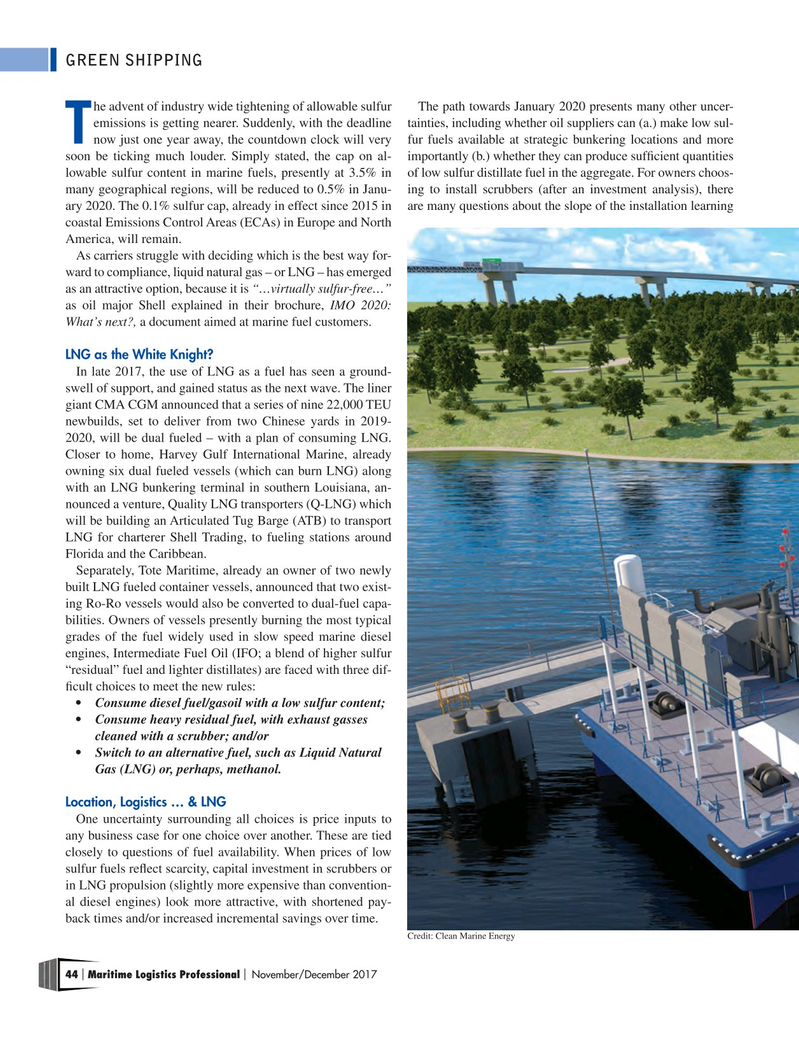
Page 44: of Maritime Logistics Professional Magazine (Nov/Dec 2017)
GREEN PORTS
Read this page in Pdf, Flash or Html5 edition of Nov/Dec 2017 Maritime Logistics Professional Magazine
GREEN SHIPPING he advent of industry wide tightening of allowable sulfur The path towards January 2020 presents many other uncer- emissions is getting nearer. Suddenly, with the deadline tainties, including whether oil suppliers can (a.) make low sul-
T now just one year away, the countdown clock will very fur fuels available at strategic bunkering locations and more soon be ticking much louder. Simply stated, the cap on al- importantly (b.) whether they can produce suffcient quantities lowable sulfur content in marine fuels, presently at 3.5% in of low sulfur distillate fuel in the aggregate. For owners choos- many geographical regions, will be reduced to 0.5% in Janu- ing to install scrubbers (after an investment analysis), there ary 2020. The 0.1% sulfur cap, already in effect since 2015 in are many questions about the slope of the installation learning coastal Emissions Control Areas (ECAs) in Europe and North
America, will remain.
As carriers struggle with deciding which is the best way for- ward to compliance, liquid natural gas – or LNG – has emerged as an attractive option, because it is “…virtually sulfur-free…” as oil major Shell explained in their brochure, IMO 2020:
What’s next?, a document aimed at marine fuel customers.
LNG as the White Knight?
In late 2017, the use of LNG as a fuel has seen a ground- swell of support, and gained status as the next wave. The liner giant CMA CGM announced that a series of nine 22,000 TEU newbuilds, set to deliver from two Chinese yards in 2019- 2020, will be dual fueled – with a plan of consuming LNG.
Closer to home, Harvey Gulf International Marine, already owning six dual fueled vessels (which can burn LNG) along with an LNG bunkering terminal in southern Louisiana, an- nounced a venture, Quality LNG transporters (Q-LNG) which will be building an Articulated Tug Barge (ATB) to transport
LNG for charterer Shell Trading, to fueling stations around
Florida and the Caribbean.
Separately, Tote Maritime, already an owner of two newly built LNG fueled container vessels, announced that two exist- ing Ro-Ro vessels would also be converted to dual-fuel capa- bilities. Owners of vessels presently burning the most typical grades of the fuel widely used in slow speed marine diesel engines, Intermediate Fuel Oil (IFO; a blend of higher sulfur “residual” fuel and lighter distillates) are faced with three dif- fcult choices to meet the new rules: • Consume diesel fuel/gasoil with a low sulfur content; • Consume heavy residual fuel, with exhaust gasses cleaned with a scrubber; and/or • Switch to an alternative fuel, such as Liquid Natural Gas (LNG) or, perhaps, methanol.
Location, Logistics … & LNG
One uncertainty surrounding all choices is price inputs to any business case for one choice over another. These are tied closely to questions of fuel availability. When prices of low sulfur fuels refect scarcity, capital investment in scrubbers or in LNG propulsion (slightly more expensive than convention- al diesel engines) look more attractive, with shortened pay- back times and/or increased incremental savings over time.
Credit: Clean Marine Energy 44 Maritime Logistics Professional November/December 2017 | |

 43
43

 45
45
